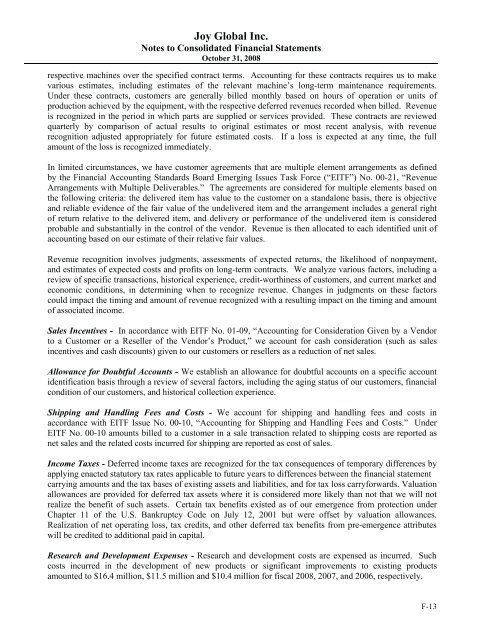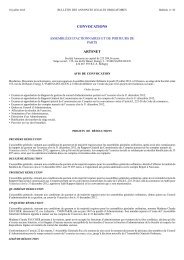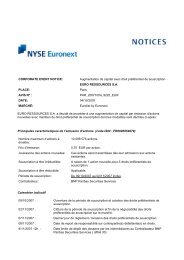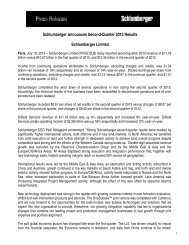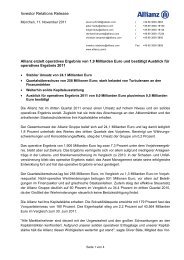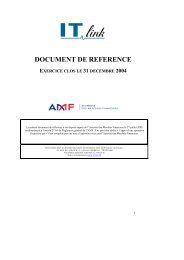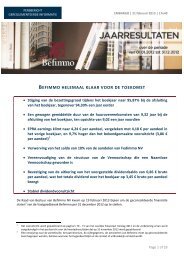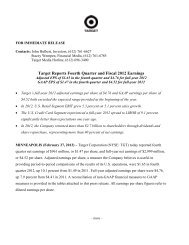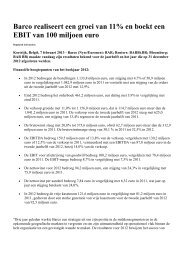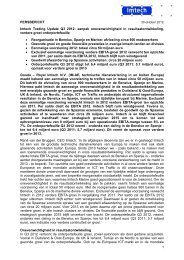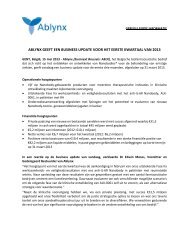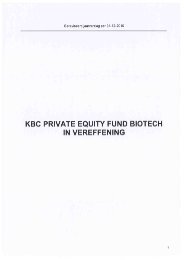GLOBAL REACH. LEADlNG TECHNOLOGY. - Zonebourse.com
GLOBAL REACH. LEADlNG TECHNOLOGY. - Zonebourse.com
GLOBAL REACH. LEADlNG TECHNOLOGY. - Zonebourse.com
You also want an ePaper? Increase the reach of your titles
YUMPU automatically turns print PDFs into web optimized ePapers that Google loves.
Joy Global Inc.<br />
Notes to Consolidated Financial Statements<br />
October 31, 2008<br />
respective machines over the specified contract terms. Accounting for these contracts requires us to make<br />
various estimates, including estimates of the relevant machine’s long-term maintenance requirements.<br />
Under these contracts, customers are generally billed monthly based on hours of operation or units of<br />
production achieved by the equipment, with the respective deferred revenues recorded when billed. Revenue<br />
is recognized in the period in which parts are supplied or services provided. These contracts are reviewed<br />
quarterly by <strong>com</strong>parison of actual results to original estimates or most recent analysis, with revenue<br />
recognition adjusted appropriately for future estimated costs. If a loss is expected at any time, the full<br />
amount of the loss is recognized immediately.<br />
In limited circumstances, we have customer agreements that are multiple element arrangements as defined<br />
by the Financial Accounting Standards Board Emerging Issues Task Force (“EITF”) No. 00-21, “Revenue<br />
Arrangements with Multiple Deliverables.” The agreements are considered for multiple elements based on<br />
the following criteria: the delivered item has value to the customer on a standalone basis, there is objective<br />
and reliable evidence of the fair value of the undelivered item and the arrangement includes a general right<br />
of return relative to the delivered item, and delivery or performance of the undelivered item is considered<br />
probable and substantially in the control of the vendor. Revenue is then allocated to each identified unit of<br />
accounting based on our estimate of their relative fair values.<br />
Revenue recognition involves judgments, assessments of expected returns, the likelihood of nonpayment,<br />
and estimates of expected costs and profits on long-term contracts. We analyze various factors, including a<br />
review of specific transactions, historical experience, credit-worthiness of customers, and current market and<br />
economic conditions, in determining when to recognize revenue. Changes in judgments on these factors<br />
could impact the timing and amount of revenue recognized with a resulting impact on the timing and amount<br />
of associated in<strong>com</strong>e.<br />
Sales Incentives - In accordance with EITF No. 01-09, “Accounting for Consideration Given by a Vendor<br />
to a Customer or a Reseller of the Vendor’s Product,” we account for cash consideration (such as sales<br />
incentives and cash discounts) given to our customers or resellers as a reduction of net sales.<br />
Allowance for Doubtful Accounts - We establish an allowance for doubtful accounts on a specific account<br />
identification basis through a review of several factors, including the aging status of our customers, financial<br />
condition of our customers, and historical collection experience.<br />
Shipping and Handling Fees and Costs - We account for shipping and handling fees and costs in<br />
accordance with EITF Issue No. 00-10, “Accounting for Shipping and Handling Fees and Costs.” Under<br />
EITF No. 00-10 amounts billed to a customer in a sale transaction related to shipping costs are reported as<br />
net sales and the related costs incurred for shipping are reported as cost of sales.<br />
In<strong>com</strong>e Taxes - Deferred in<strong>com</strong>e taxes are recognized for the tax consequences of temporary differences by<br />
applying enacted statutory tax rates applicable to future years to differences between the financial statement<br />
carrying amounts and the tax bases of existing assets and liabilities, and for tax loss carryforwards. Valuation<br />
allowances are provided for deferred tax assets where it is considered more likely than not that we will not<br />
realize the benefit of such assets. Certain tax benefits existed as of our emergence from protection under<br />
Chapter 11 of the U.S. Bankruptcy Code on July 12, 2001 but were offset by valuation allowances.<br />
Realization of net operating loss, tax credits, and other deferred tax benefits from pre-emergence attributes<br />
will be credited to additional paid in capital.<br />
Research and Development Expenses - Research and development costs are expensed as incurred. Such<br />
costs incurred in the development of new products or significant improvements to existing products<br />
amounted to $16.4 million, $11.5 million and $10.4 million for fiscal 2008, 2007, and 2006, respectively.<br />
F-13


